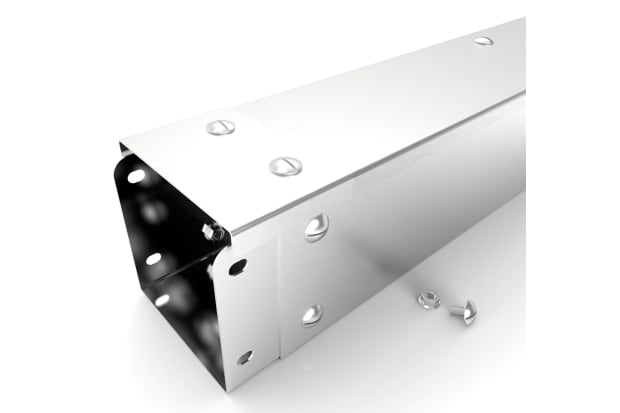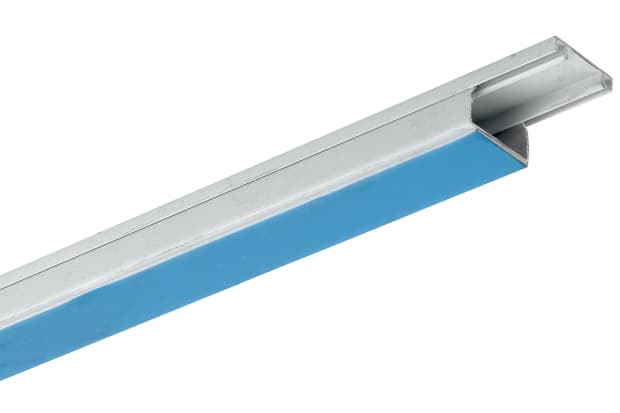- Published 24 Jan 2023
- Last Modified 29 Aug 2023
- 8 min
A Guide to Cable Conduit & Trunking
Our conduit and trunking cable guide explains how and why they are used, and how best to go about fitting them.

Reviewed by Jay Proctor, Technical Support Team Leader (December 2021)
Conduit cable, which you might also see listed as trunking cable, insulated cables, or armoured cable, refers to a length of wire or cabling intended to be run through a protective plastic or metal sheath. This protective channel is often called wire conduit or cable trunking. It may be rigid or flexible, depending on the needs of the installation.
Conduit or trunking is normally used for cable management systems where current needs to be carried between multiple devices and terminals. It’s especially useful in any potentially hazardous areas, whether the perceived hazard is environmental or physical. Ambient or weather-related conditions (e.g. moisture, extreme temperatures, etc) may be good reasons to choose conduit, trunking, and protective cable sleeving.
If conductors and cables need to be run across areas where they present a tripping or snagging hazard, floor trunking may offer some degree of protection for the physical wiring itself. However, conduit and trunking are most often used where cables will be elevated or hidden. For cabling running across an open floor surface, it can be more practical to use dedicated cable protectors and cable covers for safety.
Conduit and trunking are more often used where a raised/wall-mounted, embedded or partly concealed wiring run needs further protection. It also helps to clean up the overall appearance of your wiring as a handy cable management solution. Everyday examples include wiring runs going across ceilings, outdoor cabling, underground cable runs, or wires being chased into and around walls.
In these sorts of scenarios, using sheathed cables with trunking or conduit protection is a great way to guard against knocks, cuts, general damage/degradation, and environmental conditions. They also help protect anyone living or working in the vicinity from accidental exposure to current and voltage.
In this expert guide, we’ll cover the basics of cable conduit, including what types are available to buy online in the UK. We’ll also talk briefly about how to cut and install trunked cable indoors, on walls, and outside. To begin with, we’ll outline the relationship, similarities and differences between cable trunking and cable conduit.
How Cable Trunking Relates to Cable Conduit
We’re often asked, ‘what’s the difference between cable conduit and cable trunking?’. In practice, these two methods of electrical power cable protection and concealment are very similar. However, they each have their own advantages and disadvantages in particular applications.
Conduit is typically the cheaper and more basic approach to wiring protection. It’s widely used wherever smaller cable bundles or individual wires are being run between two terminals, from point A to point B. If they simply need to be protected, tidied up, and/or hidden from view, conduit is often the easiest option.
Cable conduit tends to take the form of a long round tube in various diameters. It can be flexible or rigid and made from several different materials, depending on where and how it’s being installed. We’ll cover some of the more popular trunking and conduit materials in the following sections of this guide.
Conduit is normally used in single long sections and cut to length as per requirements. Multiple sections and runs of conduit can be linked together and secured to walls, using various cable conduit fittings like couplings and saddles for extra rigidity if needed. Conduit diameter and capacity is widely variable, depending on the sorts of wiring runs you're passing through.
What is Cable Trunking?
Full trunking for cables is sometimes preferred to conduit in more complex installations and circuits, or where a greater capacity for routing thicker wiring bundles is needed. It’s ideal if a cabling run needs to perform numerous bends, or where larger exposed runs need to be carried neatly and efficiently around larger spaces.
Many workplaces and industrial settings use cable trunking to supply power to multiple machines or devices in different locations. You’ll often see plastic dado trunking running around the wall at waist height in offices. This is a special compartmentalised version of the system, designed for carrying several different types of wires separately along the same path.
Rigid cable trunking systems are more inherently modular than most conduit installations. Trunking sections can be either rectangular, square, or flattened for a low profile. They’re designed to slot together, often with angled joint pieces between each length.
This type of power trunking allows the user to create any shape of wiring pathway they need. Carefully planning the run and buying the appropriately angled joins allows you to achieve a highly customised set of cabling routes and bends. Again, numerous sorts of cable trunking accessories can be added to help secure the run.
Like conduit, cable trunking sizes and materials can vary widely, depending on the needs of the application. You can buy basic plastic cable trunking in grey, black or white, galvanised metal trunking, decorative and coloured cable trunking, or self-adhesive trunking (sold with a self-adhesive backing). Mini trunking is a lighter, narrower version handy for carrying minimal wiring.
Again, we’ll discuss some of these in the following section of the guide.
Types of Trunking

Metal Trunking
Metal cable conduit trunking and rigid metal conduit are among the most heavy-duty and robust options you can buy. It comes in a range of options for carrying various cables in conduit arrangements, including a wide variety of diameters and cross-sectional areas for different types of cables and sizes of cable (diameters).
Galvanised steel conduit is often preferred for outdoor and underground cable runs, or in any other places where there’s likely to be a degree of exposure to moisture. Stainless steel trunking is sometimes preferred for aesthetics where a cabling run will be in full view. Aluminium conduit is a great choice for many lightweight applications, such as when wiring needs to be run across ceilings.
As with plastic trunking and conduit, metal versions can be either round, square, or slim/flat in profile. It may be fully enclosed or slotted to allow for better thermals through rapid heat dissipation. This also enables easier access and visual identification of wires.

Plastic Trunking
Plastic cable trunking is a popular choice for a relatively simple and cheap conduit option that’s robust enough to withstand everyday hazards like dirt and moisture. It can also be bought in both rigid and flexible lengths, depending on whether you need to prioritise physical protection or routing convenience.
Common types of plastic conduit include PVC and UPVC trunking, halogen-free ABS conduit, polyamide, and polypropylene. Flat PVC cable conduit is often used around skirting or in dado installations, and white or black plastic trunking is a common sight in various workplaces, particularly offices.
Plastic trunking sizes vary widely - widths can range from 3mm to over 300mm, while depths go from under 10mm to over 100mm. Standard lengths can easily be trimmed to fit the space you’re working in, particularly if you’re choosing PVC trunking or similar. The best combination of lengths and thicknesses will depend on the routing and cable management you need, as well as the amount and type of wiring (single-core cables, multi-core cables, earth cable etc) you’re putting through.
EMC Trunking
For some types of installation, ensuring you have fully electromagnetic compatibility (EMC) between your conduit cable and trunking enclosures will be vital. Dedicated EMC cable, glands and EMC shielding can be bought to provide a screening effect for conductors, providing better earthing, helping to minimise interference, and lowering the risk of shorting or electromagnetic radiation.
Always be sure to search for products listed specifically as ‘electrical cable conduit’ or ‘electrical trunking systems’ if you’re installing this type, particularly for cabling runs with a high current carrying capacity.
How to Install Cable Trunking
In all cases of electrical installation, if you’re unsure about any aspect of working with live trunking cable, then you should always seek guidance from a qualified electrician. Installing the cable trunking itself isn’t strictly an electrical task, however, and it’s relatively easy to DIY in most cases.
Unfortunately, there’s no single rule for how to install it correctly - knowing how to install cable trunking and mini trunking is about understanding which type of product you’re buying, and what you need it to do.
Some types of conduit and cable protection are designed to be quick and easy to install, including self-adhesive trunking. Other types may snap-fit together around the cable you’re routing or require the cable to be run through beforehand. Heavier cables and more robust installations, such as full galvanised steel trunking with rigid corner joints, will be a more complicated and demanding process.
Depending on the trunking type, cable conduit size, cross-sectional area, amounts of cable and install location, you may need several additional tools to complete the installation. These can range from screwdrivers and drills to saws, putties and sealants, stud finders (wall scanners), and various others besides.
Bear in mind that installing outdoor cable trunking for waterproof cabling runs will require a different set of checks requirements than most basic indoor applications and unburied cables, such as fixing trunking to an office wall for network cables (Ethernet cables). You may also need to know how to cut cable trunking neatly for the materials you’re using, how to plaster over wires, or how to make trunking bends at a more precise angle. These sorts of instructions will often be included in the manufacturer specifications for specific products and conduit brands.